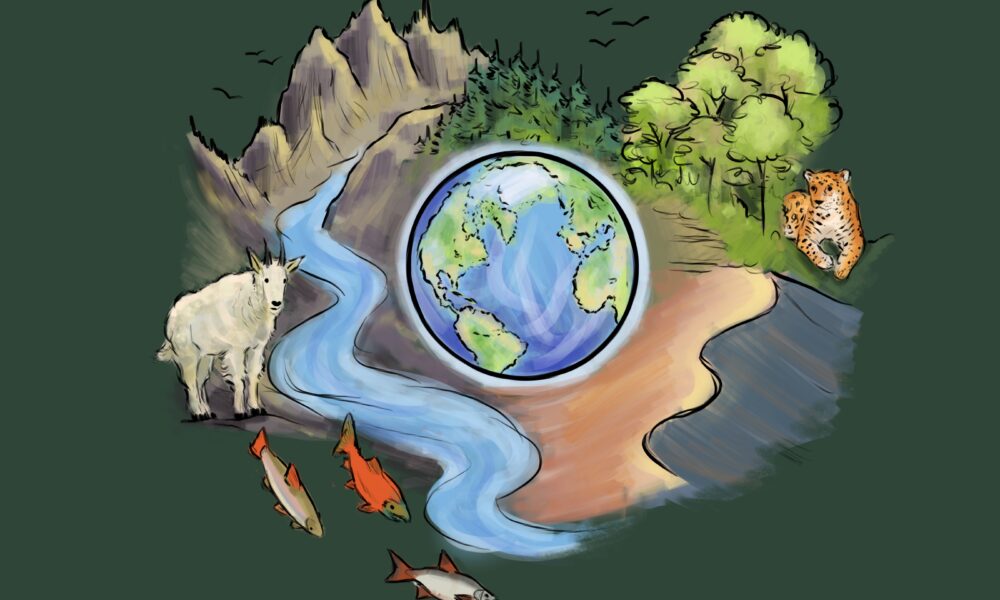2020 was a year that marked the start of the COVID-19 pandemic, the public health crisis that spurred unprecedented timelines for vaccine development. However, 2020 should be infamous for another reason—it was one of the hottest years in history. Adding insult to injury, this was not some statistical outlier: The last eight years have all been categorized as the hottest on record. The average temperature has risen by 0.08 degrees Celsius—0.14 Fahrenheit—each decade since 1880, and since 1980, that rate has more than doubled to 0.18 Celsius.
Last month, while the Qatar World Cup engrossed millions, here in Montreal, an even more momentous event occurred: The 2022 United Nations Biodiversity Summit. Also known as COP15, the event concluded on Dec. 19 and saw almost 200 countries agree to the goal of halting and reversing biodiversity loss. With a “30 by 30” target, nations pledged to conserve 30 per cent of the world’s lands, seas, and inland waters by 2030.
The targets put forth by the attending nations were grand in scope, with goals like cutting global food waste in half, reducing harmful pesticide usage, and acquiring $200 billion by 2030 dedicated to protecting biodiversity. Held at the Palais des congrès in downtown Montreal, the summit came two weeks after the United Nations Climate Change Conference, known as COP27, in Sharm El Sheikh, Egypt. In contrast, COP27 focused entirely on climate-related issues such as curbing carbon emissions and adapting to climate impacts.
The fight for climate action has been difficult, with repeated setbacks like missing the 1.5 degrees Celsius world temperature target and nations’ failures to stick to emissions pledges. In many ways, biodiversity protection is as important as meeting climate targets because biodiversity upholds the world’s ecosystems—an environment with diverse species is more stable than a homogeneous one. The overharvesting of a couple of key species of marine life was a central discussion because of how it can break down ecosystems in unpredictable ways, along with the small-scale communities dependent on them.
Kristen Lalla, BSc ‘18, MSc ‘21, and current Physical Science Officer at Environment and Climate Change Canada (ECCC), was a speaker at the conference. In an interview with The McGill Tribune, Lalla discussed her and the ECCC’s research after participating in the “Conservation Exchange: An innovative new approach to financing conservation” panel at COP15.
“We’re working on developing a biodiversity indicator that will hopefully be able to quantify the biodiversity benefits of conservation projects,” Lalla said. “[The development] has involved a lot of reading, a lot of thinking and discussions both within the team and with others, and a lot of trying things out to figure out what works and what doesn’t [….] It’s not a super straightforward process.”
However, quantifying biodiversity efforts can be challenging because there are so many aspects to consider—population, habitat size, invasive species, and pollution. If these were left unchecked, species endangerment is a possibility.
“Species at risk are a priority in Canada […] and so those species at risk have legislative population distribution goals, and we can actually use those goals to estimate the benefits relative to those goals,” Lalla explained.
By comparing the initial populations of at-risk species to post-conservation populations, a numerical value is generated to gauge the impact of preservation efforts. This initiative, known as the Conservation Exchange, will allow the Canadian government to dole out biodiversity certificates—something similar to carbon credits—to benefit entities who work on promoting preservation efforts.
In addition to Lalla’s research, Kyle Elliot, a professor in the Department of Natural Resource Sciences and Canada Research Chair in Arctic Ecology, researches Arctic avian predator ecology. Professor Elliot’s research focuses on Arctic seabird migration—one of the many avian species that are impacted by biodiversity loss.
“We’re measuring the energetics—the energy expenditure and intake of arctic seabirds—and you can imagine them as being tiny little sampling devices for us,” Elliot said. “The traditional way of studying the Arctic would be with an icebreaker which does one track—$100,000 a day–and covers some small section of the arctic [….] They’re telling us something about what is happening in the ocean, and if they have to expend a lot more energy, then things may not be as good.”
Since seabirds, such as the thick-billed murre and ivory gull, are perched at one of the highest positions on the Arctic food chain, one can determine how well an ecosystem is doing by tracking the way these predators interact with their environment. Suppose a seabird population has to go a few kilometres further to get the same amount of calories as they did a decade prior. This would indicate a substantial drop in the birds’ prey population or in their prey’s habitat size.
Currently, ECCC has over 20 initiatives ranging from the ecological gifts program, which offers tax breaks for whoever donates the rights to ecologically sensitive land; the Aboriginal Fund for Species at Risk, which supports Indigenous leadership in wildlife conservation efforts; and the Habitat Stewardship Program, which funds projects that directly contribute to the fulfillment of recovery objectives and population goals for species that fall under the Species at Risk Act (SARA).
In COP meetings, governments arrive at conferences with their own objectives in mind, so reaching a consensus often requires considerable effort and involves stripping the final resolutions of many strong commitments.
COP15’s plenary sessions saw negotiators continuously weakening proposed goals to get everyone on board. The United Kingdom delegates, for example, asked that criteria remain flexible and open to change, with other nations parroting the same complaint about the proposal’s perceived stringency.
As some wealthy countries pushed for ambitious new targets, representatives from the Global South, responsible for the world’s most biodiversity-rich ecosystems, focused on securing the funding needed to meet such goals. Toward the meeting’s end, several representatives from developing nations walked out to protest the lack of funding their countries were receiving. A prominent figure in this protest was the lead climate negotiator for Brazil, Leonardo Cleaver de Athayde. Representing the nation that arguably holds the most biodiverse forest on the planet, he was frustrated with a lack of genuine engagement from the other side of the table.
Despite these complications, the final result not only included the 30 by 30 agreement but also some commitments to fund different forms of biodiversity protection, such as promoting environmental awareness or reducing consumer waste. The European Union (EU) promised to double its international biodiversity financing to seven billion Euros for the 2021-2027 period, calling on other donors to match this effort. Countries also committed to mobilizing $200 billion USD per year in domestic and international biodiversity-related funding by 2030, with $30 billion USD per year in international finance (public and private) from “developed to developing states.”
Though these are steep figures, the impact of these policies will only be felt if countries actually stick to the agreements reached. For instance, concerns surrounding the “30 per cent restoration of land and sea” goal stem from the fact that no baseline year was established for reference.
The funding mechanism also remains vague regarding where the capital will come from and sounds eerily similar to past financing commitments that were never met. At the 2009 climate COP, countries agreed to raise $100 billion USD annually for climate action in developing countries by 2020. But this target has been missed every year so far.
All commitments to protect biodiversity still remain entirely dependent on the assumption that global warming will not decimate our environment.
“It’s fantastic to have this agreement […] these types of aspirational goals are fantastic,” Elliot said. “It’s great to create national parks and protected areas in the Arctic, but it’s not going to do anything if climate change means there’s no Arctic left.”
The enticing ambition of COP15 should be treated with caution and will require consistent pressure for meaningful success. If governments do not detail how to achieve such goals, reaching them will be nearly impossible.









